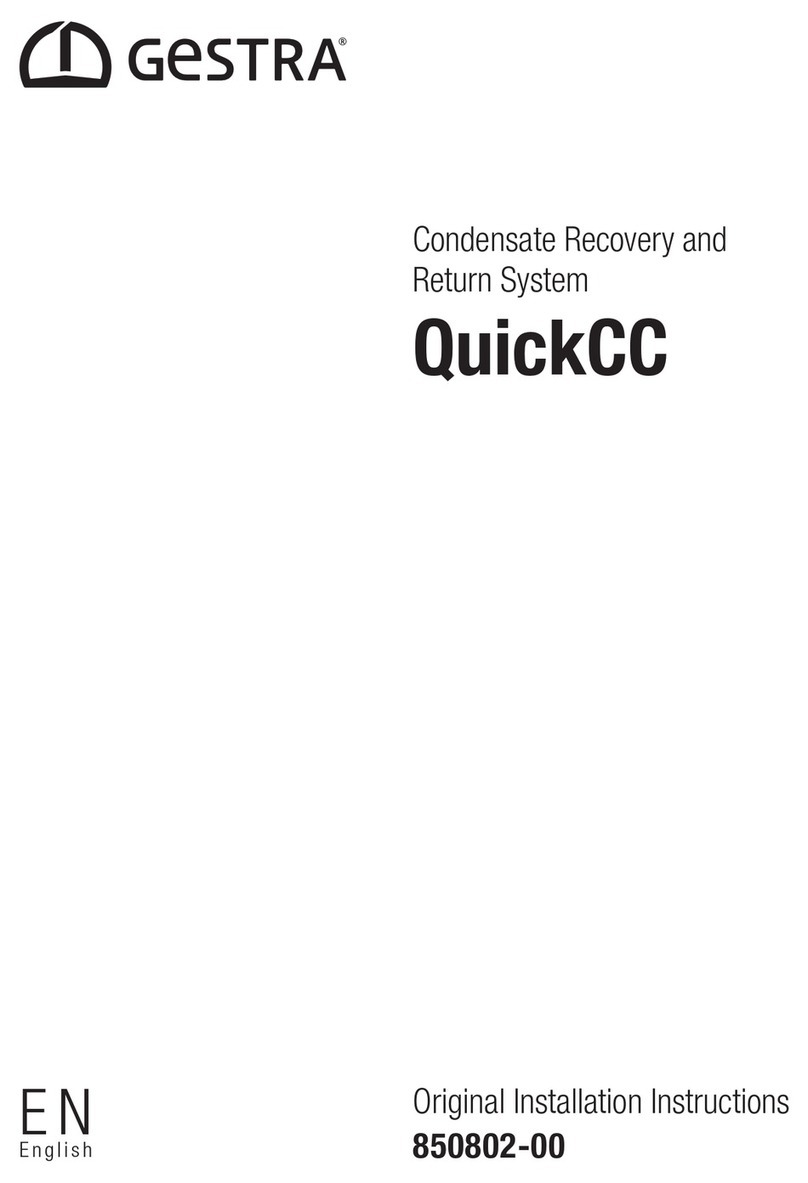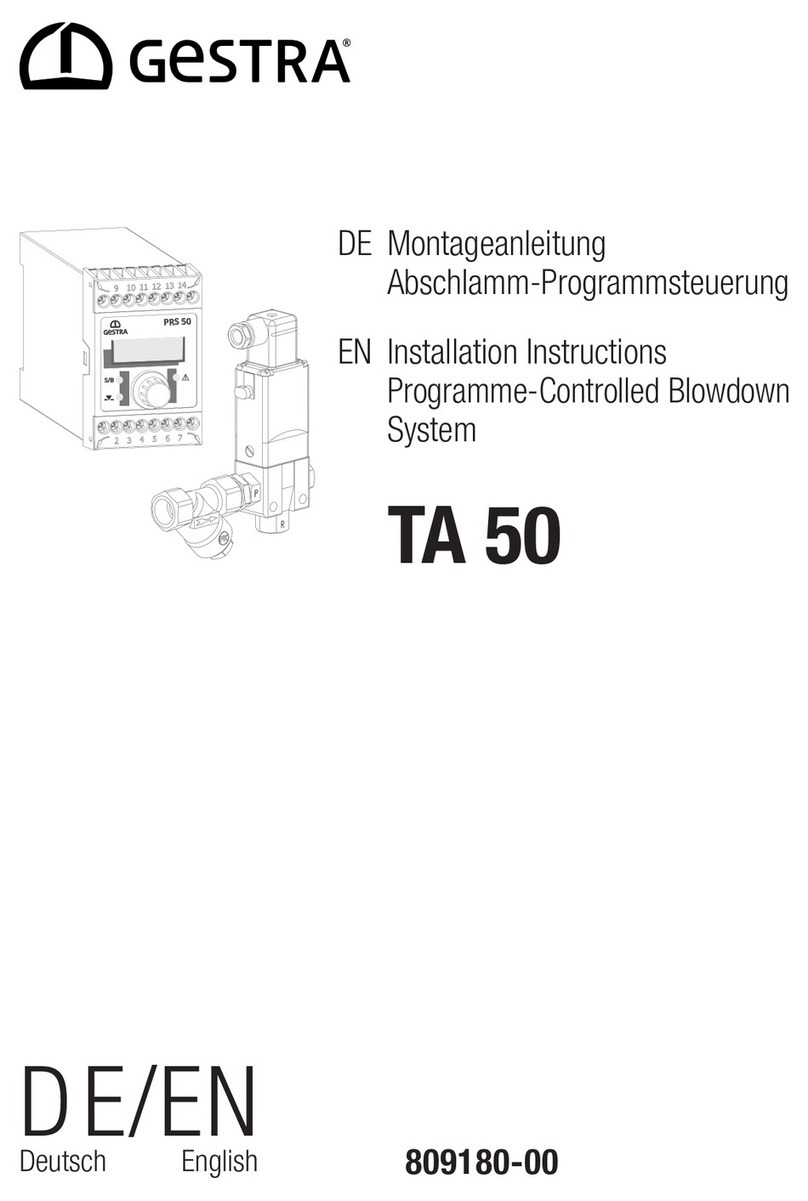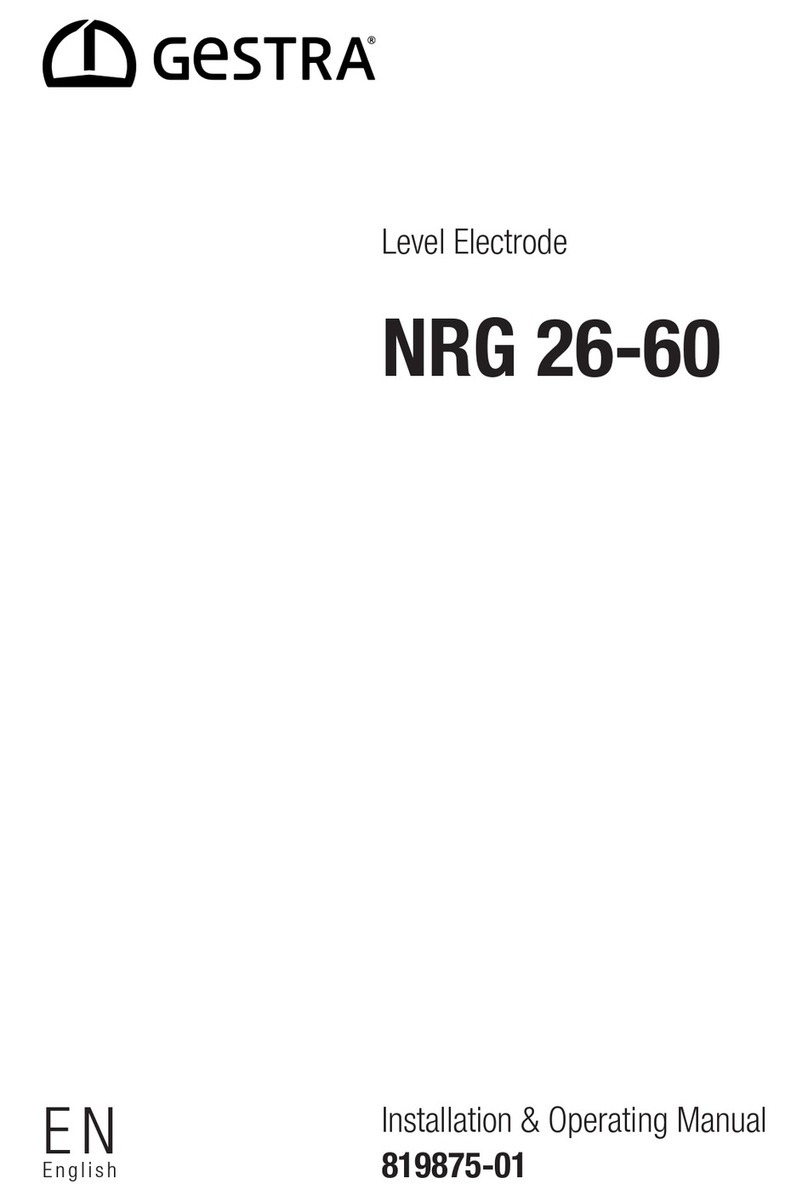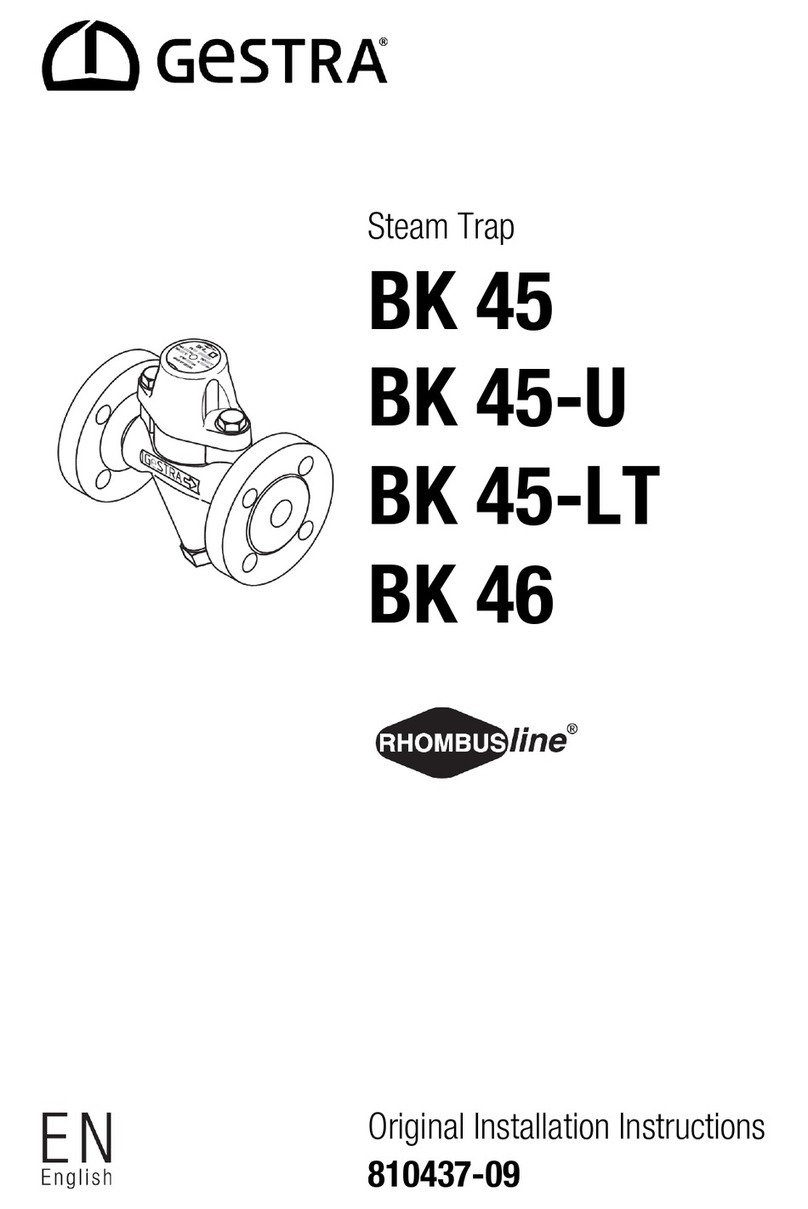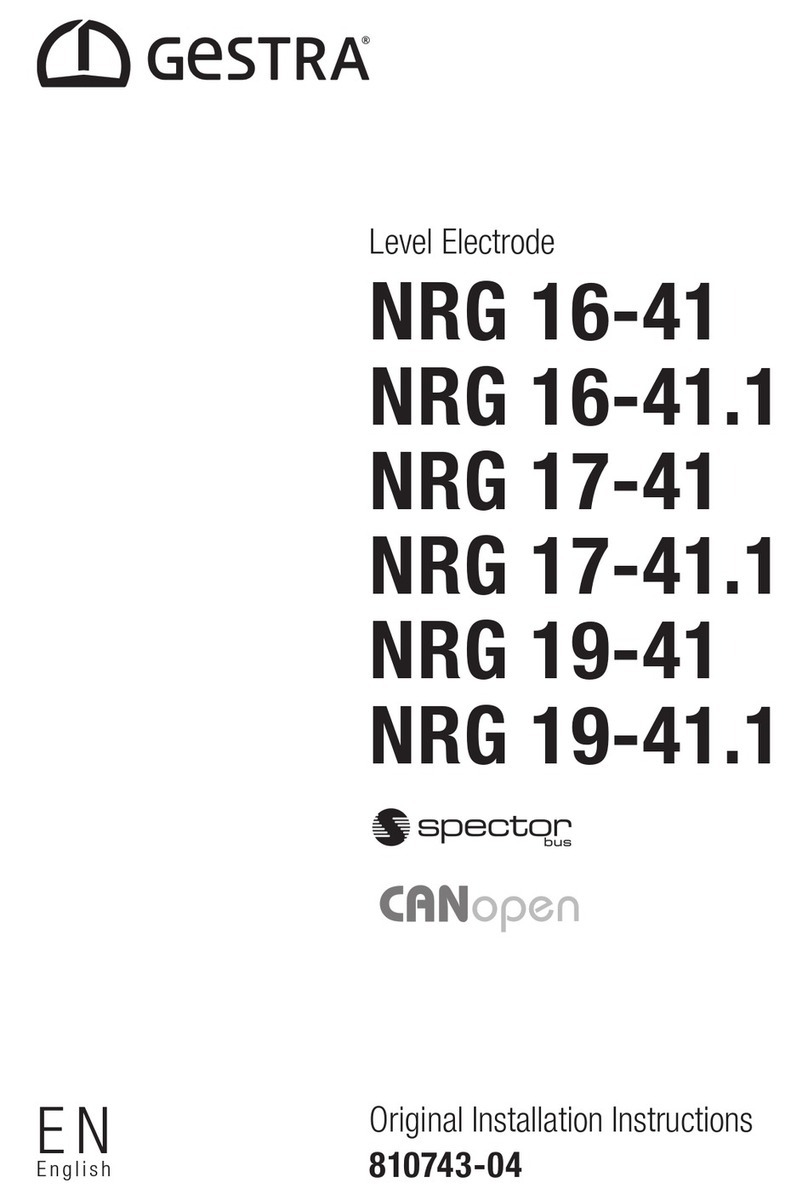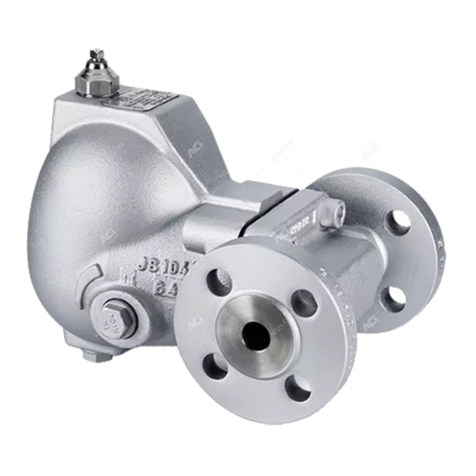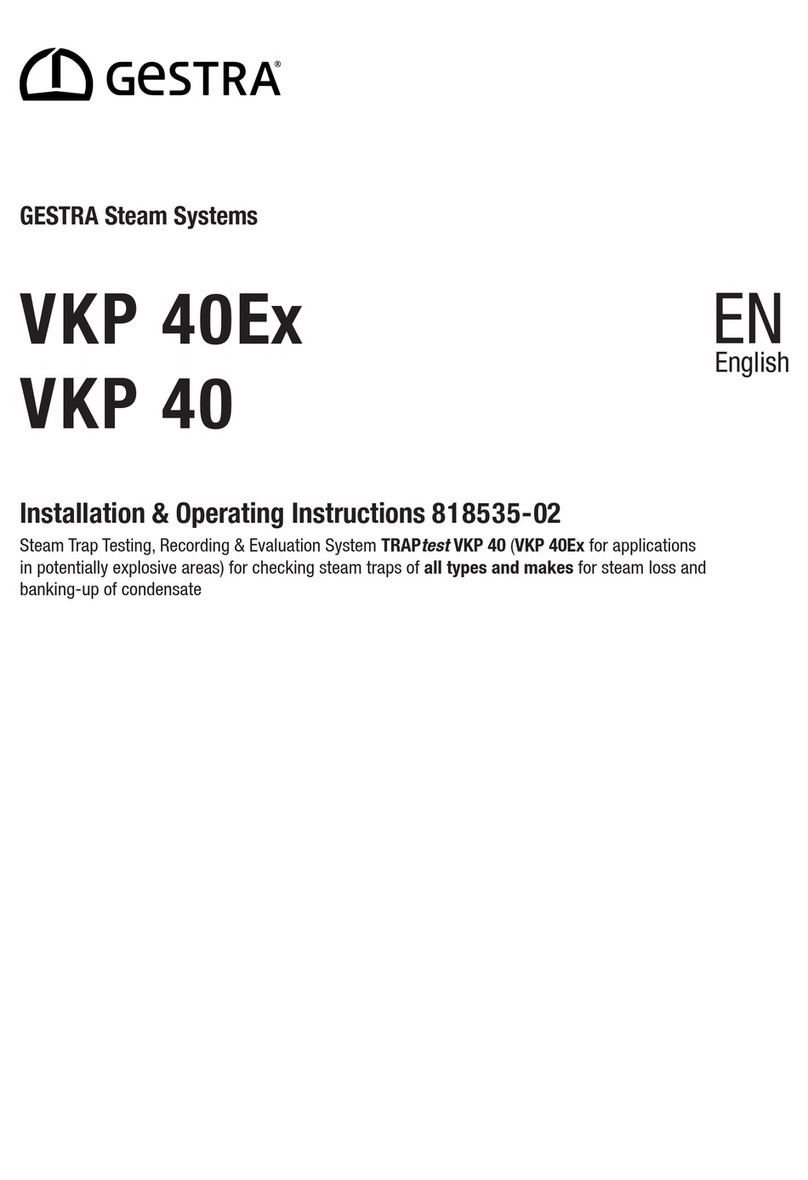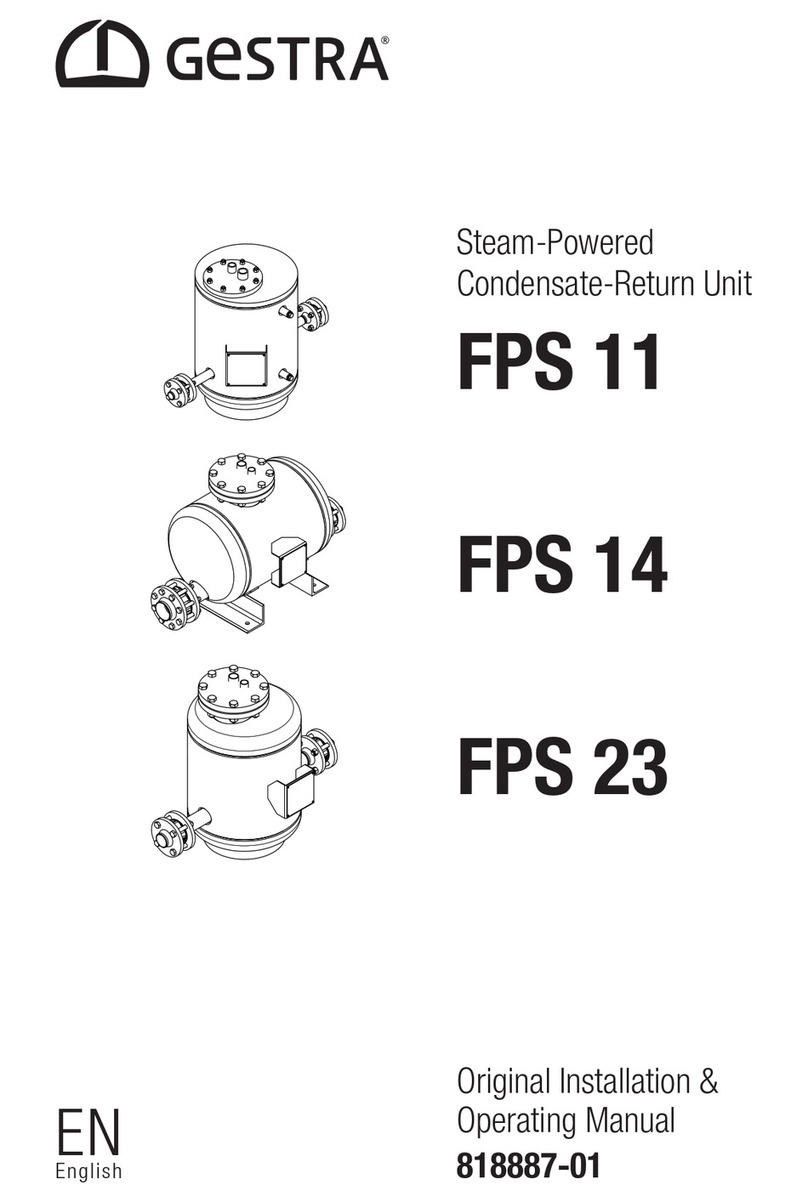GESTRA RHOMBUSline MK 45-1 User manual

Steam Trap
MK 45-1
MK 45-2
MK 45 A-1
MK 45 A-2
Original Installation Instructions
810348-12

Contents
Foreword............................................................................................................................... 3
Availability.............................................................................................................................................3
Formatting features in the document ......................................................................................................3
Safety................................................................................................................................... 3
Use for the intended purpose .................................................................................................................3
Basic safety notes .................................................................................................................................4
Information on property damage or malfunctions .....................................................................................4
Qualification of personnel.......................................................................................................................5
Protective gear......................................................................................................................................5
Typographic features of warning notes....................................................................................................5
Formatting features for warnings of property damage ..............................................................................5
Description............................................................................................................................ 6
Scope of supply and equipment specification ..........................................................................................6
Application of European Directives..........................................................................................................9
Task and function..................................................................................................................................9
Storing and transporting the equipment................................................................................... 10
Storing the equipment .........................................................................................................................10
Transporting the equipment .................................................................................................................10
Mounting and connecting the equipment ................................................................................. 10
Preparing installation ...........................................................................................................................10
Connecting the equipment ...................................................................................................................11
Operation ............................................................................................................................ 12
After operation..................................................................................................................... 12
Removing external dirt deposits............................................................................................................12
Maintaining the equipment...................................................................................................................12
Servicing the equipment and installing spare parts ................................................................................12
Troubleshooting ................................................................................................................... 17
Putting the equipment out of operation.................................................................................... 20
Removing harmful substances..............................................................................................................20
Removing the equipment .....................................................................................................................20
Re-using equipment after storage.........................................................................................................21
Returning the valve..............................................................................................................................21
Disposing of the equipment..................................................................................................................21
Technical data ..................................................................................................................... 22
Dimensions and weights ......................................................................................................................22
Pressure & temperature ratings............................................................................................................23
Declaration of Conformity – Standards and Directives ............................................................... 25

3
Foreword
This installation & operating manual will help you
use the following types of equipment safely and
efficiently for their intended purpose.
MK 45-1
MK 45-2
MK 45 A-1
MK 45 A-2
These steam traps will be called equipment in this
document.
This installation & operating manual is intended for
anyone commissioning, using, operating, servicing,
cleaning or disposing of this equipment and, in
particular, for professional after-sales service
technicians, qualified personnel and authorised and
trained staff.
All of these persons must read and understand the
content of this installation & operating manual.
Following the instructions given in this installation &
operating manual helps avoiding danger and
increases the reliability and service life of the
equipment. Please note that in addition to the
instructions given in this installation & operating
manual you must also observe all locally applicable
rules and regulations concerning the prevention of
accidents as well as approved safety guidelines for
good professional practice.
Availability
Keep this installation & operating manual together
with the plant documentation for future reference.
Make sure that this installation & operating manual
is available to the operator.
The installation & operating manual is part of the
equipment. Please hand over this installation &
operating manual when selling the equipment or
passing it on.
Formatting features in the
document
Certain text elements of this installation & operating
manual feature a specific typographic design. You
can easily distinguish the following text elements:
Standard text
Cross-reference
Listing
Sub-items in listings
Steps for action.
Here you will find additional useful
information and tips serving to assist you
in using the equipment to its fullest
potential.
Safety
Use for the intended purpose
The following thermostatic/thermodynamic steam
traps are installed in steam lines:
MK 45-1
MK 45-2
MK 45 A-1
MK 45 A-2
This equipment is designed for discharging
condensed water or air-venting pipes.
The equipment must only be used within the
allowable pressure and temperature limits and only
if the chemical and corrosive influences on the
equipment are taken into account.
Do not expose the control membrane of the
membrane regulator capsule to superheat
conditions above 5 °C.
Correct use includes compliance with the
instructions given in this installation & operating
manual, in particular obedience to all safety
instructions.
Any other use of the equipment is considered to be
improper.

4
Note that the equipment is also used incorrectly if
the materials of the equipment are not suitable for
the fluid.
Basic safety notes
Risk of severe injuries
The equipment is under pressure during
operation and can be hot or very cold,
depending on the fluid used. Only perform work
on the equipment if the following conditions are
satisfied:
The pipes must not be under pressure.
All fluid must be thoroughly removed from
pipes and the equipment.
Before carrying out any work, the higher-
level system must be switched off and
secured so it cannot be switched back on by
unauthorised persons.
Pipes and the equipment must have cooled
to a lukewarm temperature, or around 20 °C.
For equipment used in contaminated areas,
there is a risk of serious or fatal injury from
harmful substances on the equipment. Only
perform work on the equipment after it has been
thoroughly decontaminated. Wear the protective
clothing specified for the contaminated zone
during all work.
The equipment may only be used with fluids that
are not aggressive in contact with material and
seals. Otherwise, leaks may occur and hot, cold
or toxic fluid may escape.
The equipment and its components may only be
installed or removed by specialist personnel.
Specialist personnel must have knowledge and
experience in the following areas:
Producing pipe connections.
Selecting suitable lifting gear for the product
and using it safely.
Working with hazardous (contaminated, hot,
cold or pressurised) fluids.
If the admissible pressure and temperature
ratings are exceeded, the equipment may be
destroyed and hot, cold or pressurised fluid may
escape. Make sure that the equipment is always
used within the admissible pressure and
temperature ratings.
You can find information about the pressure and
temperature ratings on the name plate and in
the “
Technical data
” section.
The equipment is under pressure during
operation and can become hot or cold,
depending on the fluid used. Only bring the
equipment into service if contact with surfaces
is prevented by insulation or other protection.
Always wear protective clothing when working
on the equipment and on pipes carrying fluid.
You will find information on suitable protective
clothing in the safety data sheet for the fluid
used.
Risk of minor injuries
Sharp edges on internals present the danger of
cuts to hands. Always wear industrial gloves
when servicing the equipment.
If the equipment is inadequately supported
during installation, there is a risk of getting
crushed if it falls. Use the eyebolt to secure
lifting gear, if available. Secure the equipment
during installation so it cannot fall. Use the
eyebolt to do this, if available. Wear sturdy
safety boots.
Information on property damage
or malfunctions
Malfunctions will occur if the equipment is
installed in a wrong position or with the flow
arrow pointing in the opposite direction of the
fluid flow. This may result in damage to the
equipment or the installation. Make sure that
the flow arrow on the equipment body matches
the indicated direction of the fluid flow in the
pipe.
If the material is unsuitable for the fluid,
increased wear may occur and fluid may
escape. Make sure that the material is suitable
for the fluid used in your installation.

5
Qualification of personnel
Specialist personnel must have knowledge and
experience in the following areas:
Locally applicable explosion & fire protection
and occupational health & safety provisions
Work on pressure equipment
Producing pipe connections
Working with hazardous (hot, cold or
pressurised) fluids
Lifting and transporting loads
All information in this Installation & Operating
Manual and other applicable documentation
Protective gear
The operator must ensure that anyone working on
the equipment must wear the required protective
clothing and safety gear stipulated for the site of
installation. The protective clothing must be suitable
for the used media and must protect the wearer
against safety and health hazards associated with a
particular job to be carried out at the site of
installation. Protective clothing & equipment must
provide protection from potential hazards, in
particular from injuries to:
Head
Eyes
Body
Hand
Feet
Hearing
Note that this list is not exhaustive. The operator
must establish personal protective equipment
guidelines and specify any additional protective
gear that is required if the worker is exposed to a
specific risk at the site of installation.
Typographic features of warning
notes
DANGER
Notes with the
heading DANGER warn
against imminent dangerous situations that
can lead to death or serious injuries.
WARNING
Notes with the heading
WARNING warn
against possibly dangerous situations that
could lead to death or serious injuries.
CAUTION
Notes with the heading CAUTION warn
against dangerous situations that could
lead to minor or moderate injuries.
Formatting features for warnings
of property damage
Atten
tion!
This information warns of a situation
leading to property damage.

6
Description
Scope of supply and equipment specification
Scope of supply
Our equipment is delivered packed and ready for
assembly.
Equipment specification
No.
Designation
1
Screw
2
Name plate
3
Cover
4
Spring
5
Membrane regulator capsule
6
Nozzle insert
No.
Designation
7
Cover gasket
8
Body
9
Flow arrow
10
Strainer
11
Gasket
12
Sealing plug

7
The equipment is available with two different types
of membrane regulator capsules with the
associated nozzle insert.
MK 45-1 and MK 45 A-1
Tandem-seated membrane regulator capsule for
nozzle insert, suitable for the following
condensate flowrates:
hot: approx. 10 – 600 kg/h
cold 20 °C: approx. 0 – 1000 kg/h
MK 45-2 and MK 45 A-2
Single-seated membrane regulator capsule for
nozzle insert, suitable for the following
condensate flowrates:
hot: approx. 15 – 1100 kg/h
cold 20 °C: approx. 0 – 2800 kg/h
Please refer to the capacity charts in the
pertinent data sheet for more information
on condensate flowrates.
Tandem-seated membrane regulator capsule
for nozzle insert
No.
Designation
5 Tandem-seated membrane regulator
capsule for nozzle insert
6
Nozzle insert (with tandem seat)
The nozzle insert features an integral non
-
return valve to prevent back flow.
The membrane regulator capsules are available for
three different opening temperatures.
Type
Undercooling
5N1
Δ T approx. 10 K (standard)
5U1
Δ T approx. 30 K
5H1
Δ T approx. 5 K
Single-seated membrane regulator capsule
for nozzle insert
No.
Designation
5
Single-seated membrane regulator capsule
for nozzle insert
6
Nozzle insert (with tandem seat)
The nozzle insert features an integral non
-
return valve to prevent back flow.
The membrane regulator capsules are available for
three different opening temperatures.
Type
Undercooling
5N2
Δ T approx. 10 K (standard)
5U2
Δ T approx. 30 K
5H2
Δ T approx. 5 K

8
Markings on the membrane regulator capsule
No.
Description
13
Code number for type
14
Code letter for opening temperature
15
Code number for capacity
16
Manufacturing code
Optional extras
The following add-on equipment is available:
Blow-off valve
Ultrasonic test device VAPOPHONE®
Continuous condensate monitoring equipment
End connections
The equipment is available with the following end
connections:
Butt-weld ends
Socket-weld ends
Flanges
Screwed sockets
Name plate/identification
The following items are indicated on the name
plate:
Manufacturer
Type designation
Nominal size
Pressure rating
Max. service pressure
Max. service temperature
Max. admissible differential pressure
Max. service temperature at the corresponding
service pressure
Code letter for opening temperature of
membrane regulator capsule
The following items are indicated on the equipment
body:
Material
Direction of flow
Date of manufacturing
Mark (if required), e.g. CE, UKCA, EAC

9
Application of European Directives
Fluids
The equipment is designed for the following fluids
(in accordance with the EU Pressure Equipment
Directive or Pressure Equipment (Safety)
Regulations in the UK):
Fluids of group 2
Due consideration must be given to chemical and
corrosive influences.
Potentially explosive atmospheres
The equipment does not have its own potential
source of ignition (as per ATEX Directive). Please
pay attention to the following information:
When installed, static electricity may arise between
the equipment and the connected system.
When used in potentially explosive atmospheres,
the plant manufacturer or plant operator is
responsible for discharging or preventing possible
static charge.
If it is possible for medium to escape, e.g. through
actuating mechanisms or leaks in threaded joints,
the plant manufacturer or plant operator must take
this into consideration when dividing the area into
zones.
Task and function
This equipment is designed for discharging
condensed water or air-venting steam lines.
Condensate discharge is controlled by the
membrane regulator capsule and the associated
nozzle insert. The membrane regulator capsule is
located on top of the nozzle insert.
Function of the single-seated capsule for
nozzle insert
The membrane regulator capsule contains a liquid
filling the evaporation temperature of which is a few
degrees below the saturation temperature of water
(condensate). From cold to just below steam
temperature the fluid filling in the capsule stays
liquid and condensate is discharged.
As condensate temperature approaches steam
temperature, the capsule filling begins to evaporate
and the increased pressure forces the flexible
control membrane inside the capsule onto the
single seat, thereby closing the nozzle insert.
The control characteristic of the membrane
regulator capsule closely follows the saturated
steam curve.
Function of the tandem-seated capsule for
nozzle insert
The tandem seat capsule basically works like the
single seat capsule but features a double seat that
ensures tight shut-off and a long trap life. First the
self-centering valve cone gives steam tight shut-off.
Then, as the condensate temperatures rises, the
second seat also seals off the nozzle insert.

10
Storing and transporting the
equipment
Attention!
Equipment can be damaged if
stored or
transported improperly.
Close all openings with the sealing
plugs or covers supplied with the
equipment or use similar sealing
covers.
Protect the equipment against
moisture and corrosive atmospheres.
Please contact the manufacturer if the
specified transport and/or storage
requirements cannot be met.
Storing the equipment
Please observe the following items when storing
the equipment:
Do not store the equipment for more than 12
months.
Use the supplied sealing plugs or other suitable
seal caps in order to seal off all openings of the
equipment.
Protect the sealing surfaces and contact areas
against mechanical damage.
Protect the equipment and all components
against hard shocks and impacts.
Store the equipment only in closed rooms that
meet the following environmental conditions:
Air humidity below 50 %, not condensing
Indoor air: clean, salt-free and non-corrosive
Temperature 5–40 °C.
Make sure that all these requirements are
always met when storing the equipment.
Please contact the manufacturer if you cannot
comply with the recommended storage
conditions.
Transporting the equipment
Meet the requirements for storage also when
transporting the equipment.
Prior to transport seal off connections with
sealing plugs.
If you do not have the sealing plugs
supplied with the equipment use
appropriate seal caps to seal off the
connections.
For short distances (only a few metres) you can
transport the equipment unpacked.
When transporting the equipment over larger
distances use the original packaging.
If you do not have the original packaging use a
box that protects the equipment adequately
against corrosion and physical damage.
For a short period of time the equipment
may be transported even if the
temperature is below 0
°C, provided that
the
equipment is completely empty and
dry.
Mounting and connecting the
equipment
Preparing installation
Take the equipment out of the transport
packaging.
Check the equipment for transport damage.
Contact the manufacturer if you detect any kind
of shipping damage.
When supplied by the factory, the connections may
be sealed off with sealing plugs.
Remove sealing plugs before mounting the
equipment.
Keep the sealing plugs and the packing for
further use.

11
DANGER
Risk of extremely severe injury or death
due to burns, freezing or intoxication
during work on pipes.
Make sure that there is no hot or cold
fluid in the equipment or pipes.
Make sure that the equipment pipes
are not under pressure.
Make sure that the system is switched
off and secured so it cannot be turned
on by unauthorised persons.
Make sure that the equipment and
pipes are lukewarm.
Wear protective clothing that is
suitable for the fluid, and use suitable
personal protective equipment if
necessary.
Information on suitable protective clothing and PPE
can be found in the safety data sheet of the fluid
used.
Drain pipes until they are empty.
Switch the installation off and protect it against
unauthorised or unintended re-activation.
Connecting the equipment
DANGER
Incorrectly connected equipment can result
in accidents with extremely severe injuries
or death.
Make sure that only specialist
personnel connect the equipment to
the pipe.
Make sure that the direction of flow in
the pipe matches the flow direction
arrow on the equipment.
Make sure that the connected pipe
does not subject the body to any
stress (forces or torques) during
installation and operation.
Specialist personnel must have knowledge and
experience of the type of pipe connection used.
Attention!
Equipment will be damaged if the end
connections are undersized.
Make sure that the connections are
strong and rigid enough to support th
e
weight of the equipment and to
withstand the forces that occur during
operation.
To allow easy access for routine servicing and
exchanging components observe the indicated
withdrawal distances and allow for clearances to
adjacent installation parts.
For more information see page 22.
Make sure that the pipe system of the plant is
clean.
Preferred installation of the equipment with the
strainer insert hanging downwards.
Other installation orientations of the
strainer are possible in exceptional cases.
Attention!
Any installation position where the strainer
insert does not point downwards may
impair the correct function of the
equipment.
Please consult the factory with
installation details if the equipment
cannot be installed in your installation
with the strainer hanging downwards.
Make sure that the equipment is free from
foreign matter.
Attention!
Welding might damage the membrane
regulator capsule.
Remove the membrane regulator
capsule before welding.
For more information see page 15.
Install the equipment in the desired, permitted
installation position.

12
Make sure that the equipment is safely mounted
and that all connections are made correctly.
Attention!
Malfunctions may occur if the equipment
or condensate line
is insulated.
Make sure that the heat generated by
the equipment or the condensate line
is dissipated.
Operation
Do not work on the equipment while it is operating.
After operation
DANGER
If the equipment is used in contaminated
areas there is a risk
of severe injuries or
death caused by harmful substances in or
on the equipment.
Only qualified personnel are allowed to
perform work on contaminated
equipment.
Always wear the protective clothing
prescribed for contaminated areas
when working on the equipment.
Make sure that the equipment is
completely decontaminated before
carrying out any service work.
Follow the pertinent instructions for
handling the hazardous substances in
question.
DANGER
Risk of extremely severe injury or death
due to burns, freezing or intoxication if
fluid escapes.
Make sure that connections and
valves are tight after any work on the
equipment.
Make sure that equipmen
t gaskets are
intact.
Attention!
Frost damage may occur when the
installation is shut down.
Drain the equipment if ambient
temperatures below 0 °C (frost) ar
e to
be expected.
Removing external dirt deposits
To remove dirt deposits rinse the equipment
with fresh water and wipe it with a clean, lint-
free cloth.
To remove any persistent residues use a
cleaning agent that is suitable for the material
and carefully wipe the equipment with a clean,
lint-free cloth.
Maintaining the equipment
You can check the equipment for correct operation
using the GESTRA ultrasonic measuring unit
VAPOPHONE®.
For more details refer to the installation &
operating manual of the ultrasonic measuring
unit.
Continuous steam trap monitoring is recommended
for critical applications.
For more details refer to the installation &
operating manual of the continuous steam trap
monitoring unit.
Servicing the equipment and
installing spare parts
You may exchange the following component parts
in case of wear or damage:
Membrane regulator capsule with nozzle insert,
complete
Membrane regulator capsule
Strainer
Cover gasket
Gasket

13
Replace components only with genuine spare
parts from the manufacturer.
Spare parts for version with tandem seat
No.
Designation
Stock code #
MK 45-1
MK 45A-1
5, 6, 7
Tandem-seated membrane regulator capsule 5N1 and
nozzle insert, complete
375 109
375 109
Tandem-seated membrane regulator capsule 5U1 and
nozzle insert, complete
375 111
375 111
Tandem-seated membrane regulator capsule 5H1 and
nozzle insert, complete
378 521
378 521
10, 11, 12
Strainer with sealing plug and gasket
375 113
375 382
5
Tandem-seated membrane regulator capsule 5N1 for
nozzle insert *
376 165
376 165
Tandem-seated membrane regulator capsule 5U1 for
nozzle insert *
376 166
376 166
Tandem-seated membrane regulator capsule 5H1 for
nozzle insert *
376 173
376 173
7
Cover gasket **
375 159
375 159
11
Gasket **
375 162
375 162
*: Packaged 10 pcs. per box. Contact your local dealer for smaller quantities.
** Packaged 50 pcs. per box. Contact your local dealer for smaller quantities.

14
Spare parts for version with single seat
No.
Designation
Stock code #
MK 45-2
MK 45A-2
5, 6, 7
Single-seated membrane regulator capsule 5N2 and
nozzle insert, complete
375 110
375 110
Single-seated membrane regulator capsule 5U2 and
nozzle insert, complete
375 112
375 112
Single-seated membrane regulator capsule 5H2 and
nozzle insert, complete
377 589
377 589
10, 11, 12
Strainer with sealing plug and gasket
375 113
375 382
5
Single-seated membrane regulator capsule 5N2 for nozzle
insert *
376 167
376 167
Single-seated membrane regulator capsule 5U2 for nozzle
insert *
376 168
376 168
Single-seat membrane regulator capsule 5H2 for nozzle
insert *
376 174
376 174
7
Cover gasket **
375 159
375 159
11
Gasket **
375 162
375 162
*: Packaged 10 pcs. per box. Contact your local dealer for smaller quantities.
** Packaged 50 pcs. per box. Contact your local dealer for smaller quantities.

15
Removing the membrane regulator capsule
and nozzle insert
To clean and, if necessary, discard and replace the
membrane regulator capsule and the nozzle insert
proceed as follows:
Use a 16 mm open-end spanner (US: wrench) to
unscrew the two screws from the body.
Lift the cover off the body.
Remove the cover gasket.
Take the membrane regulator capsule off the
nozzle insert.
Use a 22 mm open-end spanner (US: wrench) to
unscrew the nozzle insert from the body.
Cleaning the membrane regulator capsule and
nozzle insert
Clean the membrane regulator capsule and the
nozzle insert with fresh water and a lint-free
cloth.
Clean gasket seating surfaces.
Checking the component parts for damage
Check the removed parts for visible signs of
wear or damage.
Discard and replace any damaged part.
Checking the membrane regulator capsule
Use a depth gauge to check the dimension x of
the membrane regulator capsule as shown in
the following drawing.
The membrane regulator capsule is intact if your
readings match the values indicated in the following
table.
Type
Intact
Defective
Tandem-seated
membrane regulator
capsule for nozzle
insert
5N1, 5U1, 5H1
x > 2.9 mm
x < 2.9 mm
x = 2.9 mm
Single-seated
membrane regulator
capsule for nozzle
insert
5N2, 5U2, 5H2
x > 4.0 mm
x < 4.0 mm
x = 4.0 mm
Discard and replace defective membrane
regulator capsule with a new one.
Mounting the membrane regulator capsule
and nozzle insert
To install the membrane regulator capsule and the
nozzle insert proceed as follows:
Apply heat-resistant lubricant to the following
surfaces:
all threads
the seating surface of the nozzle insert
the seating surface of the cover
Use a 22 mm open-end spanner (US: wrench) to
screw the nozzle insert into the body and tighten
with a torque of 90 Nm.
Press the membrane regulator capsule onto the
nozzle insert.
The membrane regulator capsule snaps into place.
If the cover gasket is damaged replace it with a
new one.
Put the cover gasket into the body.
Put the cover onto the body.
Tighten the screws alternately and in several
steps with a torque of 25 Nm.

16
Removing and cleaning the strainer
To remove and, if required, clean or replace the
strainer proceed as follows:
Use a 30 mm open-end spanner (US: wrench) to
unscrew the sealing plug from the body.
Remove the gasket.
Take out the strainer.
Clean the sealing plug, the gasket and the
strainer with fresh water and a clean lint-free
cloth.
Clean gasket seating surfaces.
Checking the component parts for damage
Check the removed parts for visible signs of
wear or damage.
Discard and replace any damaged part.
Mounting the strainer
To remove the strainer proceed as follows:
Apply heat-resistant lubricant to the thread of
the sealing plug.
If the gasket is damaged replace it with a new
one.
Put the gasket onto the sealing plug.
Insert the strainer into the sealing plug.
Use a 30 mm open-end spanner (US: wrench) to
screw the sealing plug into the body and tighten
with a torque of 75 Nm.

17
Troubleshooting
Fault
Cause
Remedy
The steam trap is cold or only
hand-hot.
The shut-off valves for
condensate inlet or outlet are
closed.
Open the shut-off valves.
The condensate inlet or outlet
is dirt clogged.
Clean the pipes.
Clean the equipment.
The steam trap is blowing off
live steam.
The membrane regulator
capsule and the nozzle insert
are dirty.
There are dirt deposits in the
equipment.
Clean the membrane regulator capsule
and the nozzle insert.
Clean the strainer and the equipment.
Replace the membrane regulator capsule
and the nozzle insert.
The membrane regulator
capsule and the nozzle insert
are worn down.
The seat is leaking.
Replace the membrane regulator capsule
and the nozzle insert.
The bypass is open.
Close the bypass.

18
Fault
Cause
Remedy
Insufficient condensate
discharge.
Insufficient thermal output for
the user.
The shut-off valves for
condensate inlet or outlet are
closed.
Open the shut-off valves.
The condensate inlet or outlet
is dirt clogged.
Clean the pipes.
Clean the equipment.
R
eplace the membrane regulator capsule
and the nozzle insert.
Steam pressure and
condensate flowrates fluctuate
considerably.
The pressure upstream of the
steam trap is too low for the
used trap type.
Use a different steam trap type.
Contact the manufacturer to find out
which trap type is the most suitable for
your application.
The steam trap is undersized.
Use a steam trap with a larger
condensate discharge capacity.
The differential pressure is too
small.
Increase the steam pressure.
Lower the pressure in the condensate
line.
Check the size of the condensate line.
Install a steam trap with a larger
condensate discharge capacity, a pump
steam trap or a condensate return unit.
The distance between the drain
point and the steam trap is too
small.
Install the uninsulated steam trap approx.
1 - 2 m away from the drain point.
Do not insulate the condensate line and
lay it with a gradient so that the
condensate is free to fall towards the
steam trap.
The condensate line does not
have a slight fall from the the
drain point towards the steam
trap.
The condensate is lifted
upstream of the steam trap.
Lay the condensate line with a gradient
so that the condensate is free to fall
towards the steam trap.
Cha
nge the orientation of the condensate
line.
The condensate temperature is
higher than the service
temperature of the steam trap.
The regulator does not open or
only with a time delay.
If the steam trap of the condensate line is
insulated remove the insulation.
Use a different steam trap type.

19
Fault
Cause
Remedy
Insufficient deaeration.
Provide additional deaeration.
Use a different steam trap type.
Contact the manufacturer to find out
which trap type is the most suitable for
your application.
Fluid escapes (equipment is
leaking).
The end connections are
untight.
Seal off the end connections (e. g.
flanged or screwed ends).
A gasket on the body is
defective.
Replace the gasket with a new one.
The body has been damaged
by corrosion or erosion.
Check the resistance of the body material
for the fluid used.
Use a steam trap made from a material
that is suitable for the fluid used.
The body has been damaged
by frost.
Replace the equipment with a new one.
When shutting down the installation
make sure that the condensate lines and
the steam trap are completely drained.
The body has been damaged
by waterhammer.
Replace the equipment with a new one.
Take appropriate measures to protect the
equipment against waterhammer, e. g.
by installing suitable non-return valves.
If faults occur that are not listed above or cannot
be corrected, please contact our Technical
Service or authorized agency in your country.

20
Putting the equipment out of
operation
Removing harmful substances
DANGER
If the equipment is used in contaminated
areas there is a risk
of severe injuries or
death caused by harmful substances in or
on the equipment.
Only qualified personnel are allowed to
perform work on contaminated
equipment.
Always wear the protective clothing
prescribed for contaminated areas
when working on the equipment.
Make sure that the equipment is
completely decontaminated before
carrying out any service work.
Follow the pertinent instructions for
handling the hazardous substances in
question.
Qualified personnel must have extensive experience
with and a working knowledge of:
pertinent rules and regulations concerning
handling hazardous substances
special regulations for handling the hazardous
substances encountered on site
using the required personal protective
equipment (PPE) and clothing
CAUTION
Environmental damage may be caused by
poisonous fluid residues.
Before disposing of the equipment
make sure that it is clean and free of
fluid residues.
For the disposal of all materials
observe the pertinent legal regulations
concerning waste disposal.
Remove all residues from the equipment.
For the disposal of all residues observe the
pertinent legal regulations concerning waste
disposal.
Removing the equipment
DANGER
Risk of extremely severe injury or death
due to burns, freezing or intoxication
during work on pipes.
Make sure that there is no hot or cold
fluid in the equipment or pipes.
Make sure that the equipment pipes
are not under pressure.
Make sure that the system is switched
off and secured so it cannot be turned
on by unauthorised persons.
Make sure that the equipment and
pipes are lukewarm.
Wear protective clothing that is
suitable for the fluid, and use suitable
personal protective equipment if
necessary.
Information on suitable protective clothing and PPE
can be found in the safety data sheet of the fluid
used.
CAUTION
Risk of injuries if the equipment falls down.
When removing the equipment make
sure the it is safely held in place and
cannot fall down.
Suitable measures are for instance:
Equipment that is not too heavy may be
supported by a second person.
For heavy equipment use suitable lifting
equipment of sufficient strength.
Detach the end connections of the equipment
from the pipes.
Put the equipment onto a suitable base.
Store the equipment as described on page 10.
This manual suits for next models
3
Table of contents
Other GESTRA Industrial Equipment manuals
